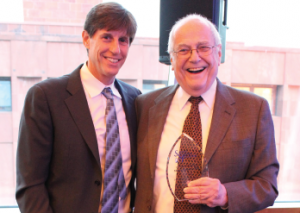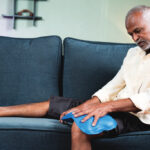
Ulf Wittrock / shutterstock.com
When Harry Spiera, MD, stepped out of the New York University School of Medicine in 1958, rheumatology was in its infancy. Obviously, much has changed for both the physician and the specialty over the 58 years between then and his recent retirement.
“Early on, rheumatology was the most clinical of the specialties, because the science just wasn’t there yet,” says Dr. Spiera. “At that time, we were just starting to look at the rheumatic diseases in a serious and systematic way. That fascinated me.”
Over the years, research has made great strides in identifying rheumatic diseases and, at least as importantly, their treatment. When he began his career, rheumatoid arthritis (RA) was almost always a crippling and debilitating disease. Now, it is possible to stabilize patients and stop the progression of the disease.
“Rheumatology is not just a job, it is a part of who he is,” says Robert Spiera, MD, of his father. Dr. Robert Speira is Harry’s son and the director of the Scleroderma and Vasculitis Center at the Hospital for Special Surgery in New York City. “He suffered with this patients, he had joy with his patients, and recognized that any interaction you have with a patient is deeply important to them and their families.”
Groundbreaking Work in PMR

Father and son: Harry Spiera, MD (right), with Robert Spiera, MD (left).
Dr. Harry Spiera contributed to the advancement of science of rheumatologic diseases via his groundbreaking work in polymyalgia rheumatica (PMR). Criteria had been established for diagnosing other illnesses, but he noted a subset of elderly patients who appeared to be in good health who suddenly complained of stiffness and pain in the shoulder and hips.
PMR affects 1% of those over 50 at some time in their lives. Before Dr. Spiera published his series on multiple American patients in the 1960s, the only other work in the field had been a few cases studies in Europe.
That first series of 15 patients has, over the years, led to PMR becoming a well understood and accepted disease. He calls it “the most interesting and clinically satisfying part of my career.”
“It was his skill as a hands-on clinician who was in the room and really listening to the patient that helped lead to the recognition of PMR as an important inflammatory condition of the elderly,” says Dr. Robert Spiera. “He saw people coming to him with pain, but with a different quality than usual. His ability to listen enabled him to realize he was looking at something that hadn’t been previously described.”
In all of medicine, increased emphasis is being placed on technology and the use of guidelines and algorithms in responding to disease. Although rheumatology has certainly participated in these changes, the subspecialty still involves a large clinical component.
SLE Lupus Foundation & His Office Couch
Dr. Harry Spiera’s patient-centered outlook during his 40+ year tenure as chief of rheumatology at Mount Sinai Hospital in New York City also put him at the inception of what grew to be major players in education, research and advocacy.
“The SLE Lupus Foundation basically started on the couch in my office,” says Dr. Spiera. “Susan Golick was a young patient of mine with the disease. From a few women getting together in their living rooms, it evolved into the Lupus Research Alliance of today. The Alliance supports education, research and publicity to more widely spread knowledge of the disease.”
Changes in Education
Dr. Harry Spiera says that rheumatology has also matured in the education of physicians, both in the subspecialty and during medical school. It used to be that exposure to rheumatolgy in medical schools consisted of one or two lectures. This was despite the fact that rheumatic diseases were some of the most common. Now, medical students have a much greater depth of education on these diseases.
“When I started my fellowship training, there were no more than 100 or 200 fellows in the entire U.S,” he noted. “Now, there are more than 70 major programs.”
Dr. Harry Spiera’s fellowship was at Columbia University under Charles Christian, MD, one of the great leaders in the field.
“Those that mentored me were important,” says Dr. Harry Spiera. “When someone is a fellow, it is a close relationship between them and their director. Most fellows, especially in the early years, became heads of their own divisions. It was a very exciting and challenging experience.”
Dr. Harry Spiera was in Dr. Christian’s first group of fellows. Dr. Robert Spiera was in the last.
Trained Rheumatology’s Leaders
Dr. Harry Spiera contributed to the training of several generations of rheumatologist. It has made an impact on many active in the specialty.
“Almost every conference I attend, I am approached by somebody who says Dad was one of their most important influences as a student or a resident,” says Dr. Robert Spiera. “Many of the leaders in rheumatology today were inspired by him. This is a critical part of his educational legacy.
“What is most remarkable about [Dad] is that he is a triple threat,” Dr. Robert Spiera continues. “He is the quintessential clinician, an incredible educator and a leader in academic rheumatology that moved the field forward.”
Retirement Relative Term
Retirement is a relative term, in this case. Although Dr. Spiera is leaving behind personal care, he still plans to attend clinics, go to conferences and stay active in rheumatology.
“We are in a field that is still growing and are just beginning to get a better understanding of rheumatic diseases,” Dr. Spiera says. “[Although] we are doing well now, I think we will be doing so much better in the next 20 to 30 years based on scientific advances and new treatments.”
Many of these advances and treatments were made possible by the contributions made over a nearly 60-year-long career.
Kurt Ullman has been a freelance writer for more than 30 years and a contributing writer to The Rheumatologist for 10 years.


